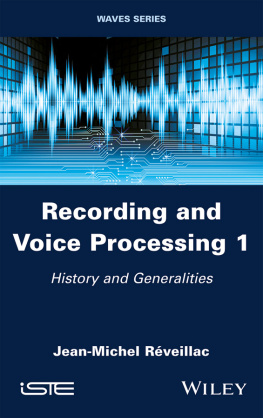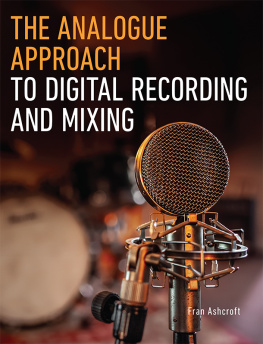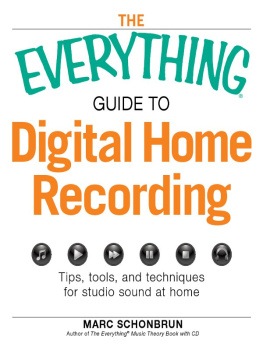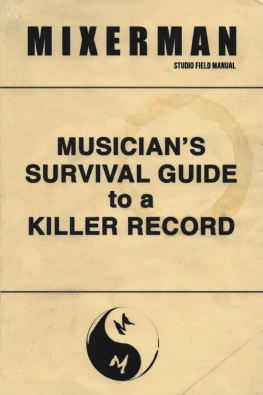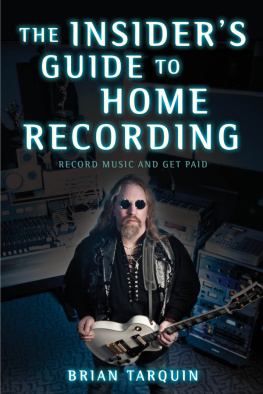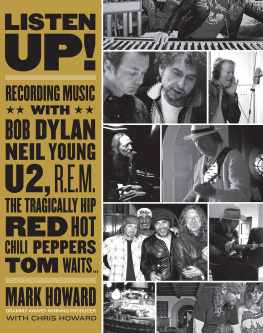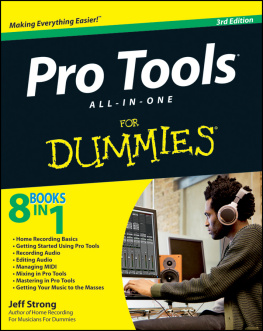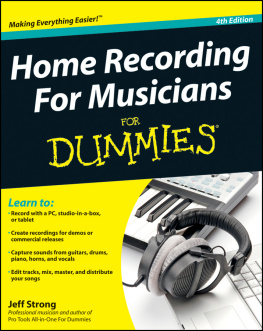Copyright 2014 by Alan Parsons and Julian Colbeck
All rights reserved. No part of this book may be reproduced in any form, without written permission, except by a newspaper or magazine reviewer who wishes to quote brief passages in connection with a review.
Published in 2014 by Hal Leonard Books
An Imprint of Hal Leonard Corporation
7777 West Bluemound Road
Milwaukee, WI 53213
Trade Book Division Editorial Offices
33 Plymouth St., Montclair, NJ 07042
Printed in the United States of America
Book design by Damien Castaneda
Book composition by Bill Gibson
All images in this book are taken from the Alan Parsons Art & Science of Sound Recording DVD series or from the authors personal collections, except as noted below or with the images themselves. Any inadvertent omission of credit brought to our attention will be remedied in future editions.
Cartoon artwork by Cliff Mott
Technical illustrations and graphs by Bill Gibson
Library of Congress Cataloging-in-Publication Data
Parsons, Alan.
Alan Parsons art & science of sound recording : the book / Alan Parsons and Julian Colbeck.
pages cm
Includes bibliographical references and index.
1. Parsons, Alan. 2. Popular musicProduction and direction. I. Colbeck, Julian. II. Title.
ML429.P335A5 2013
621.3893--dc23
2013021717
www.halleonardbooks.com
Contents
A great debt of thanks is owed to many people who inspired, contributed to, and helped behind the scenes on both the Art & Science of Sound Recording video series and this book that is based on it:
Chuck Ainlay, Scott Austin, Erykah Badu, Andrew Barta, Delia Bernal, Athan Billias, Niko Bolas, Gary Boss, Bob Bradley, Will Bright, Tulsi Briones, Dave Bristow, Tony Brown, Paul Buff, Pat Caddick, John Cerullo, Steve Clarke, Abi Colbeck, Annie Colbeck, Cameron Colbeck, Victoria Cole, Kim Copeland, Sharon Corbitt-House, Ben Cruz, Rachel Dean, Richard Dodd, Thomas Dolby, Jack Douglas, Jimmy Douglass, Roxana Drexel, Nathan East, John Fields, Ian Gilby, Brian Granfors, Susannah Grant, Jackie Green, Ashley Greer, Norm Hajjar, Danny Hakin, Gavin Haverstick, Taylor Hawkins, Rami Jaffee, Ashley Jones, Raymond Jones, Carol Kaye, Kevin Kennedy, Peter Kerns, Hal Ketchum, Chris Killen, Andrew Kitchenham, Kaz Kobayashi, Dale Krevens, Miguel Lazaro, Ledfoot, AJ Lemos, Patrick Leonard, Lisa Liu, Michael Logue, Tim Martin, Steve Marcantonio, Sylvia Massy, John McBride, Michael McDonald, Megan McDuffee, Angel Moon, Robin Moore, Spencer Nilsen, Paul Nugent, P. J. Olsson, Greg Ondo, David and Stacy Pack, Lisa Parsons, Chris Pelonis, Joe Perry, Simon Phillips, Tim Pierce, Jack Joseph Puig, Bill Putnam Jr., Coley Read, Record One Studios, Simon Rhodes, Tony Rita, Lisa Roy, Craig Russo, Sami Ryan, Chris Sampson, Elliot Scheiner, Margaret Sekelsky, John Shanks, Terry Shields, Allen Sides, Brad Smith, Dave Smith, Robin Sones, Karyn Soroka, Charlie Steves, Craig Stubblefield, Shinichi Takenaga, Bruce Tambling, Phil Taylor, David Thoener, Martin Thomas, Terry Thomas, Billy Bob Thornton, Matt Ward, Jason Ware, Tom White, Russell Wiener, Josh Wimmer, and Casey Young.
Wed also like to add our special thanks to two people in particular whose contributions form crucial parts of the book: Tim Pierce, whose guitar playing and observations thereon are simply in a league of their own, and Simon Phillips, who is to drumming what Bill Nye is to science.
Hello there!
Is this hello for the very first time, or have you got the video series as well? If the former, we also produced a video series entitled Alan Parsons Art & Science of Sound Recording , and this book is both based upon and an extension of territory we covered in the videos. We hope you will find one to be a good companion to the other.
Alan Parsons Art & Science of Sound RecordingThe Book is a complete rewrite and reappraisal of the original video version. Because it is a book and not an audio-visual experience, weve been able to examine all of the topics in greater detail. With the videos we strove to keep you visually and aurally entertained. Now, you can be reading this at home, or in a busy Starbucks, or on a plane... you can read one page at a sitting, or one chapter, or just dive in here and there using the index or the glossary. Ingest the words, look at the pictures and diagrams, and if something is not clear first time around, well, read it again. Itll make sense eventually; promise.
The great thing about a book is that you can go at your own pace. Plus its the ultimate in nonlinear formatting. You can flip from here to page 145 in less than a heartbeat. Eat your heart out, modern media! (Readers of the ebook version possibly have the best of all worlds, of course.)
For the book, we have kept the same basic tone as the video. We hope it is both intriguing for the newcomer to recording and interesting to the seasoned professional. Weve dug a little deeper into all aspects of recording technology. Chapter 1, A Brief History of Recording, may still be a relatively brief version, but its now not quite so on a pinhead.
A question that often cropped up on the video series was, How do I use the videos? What order should I view them in? Sensing potential for the same line of enquiry here, heres what we recommend you do.
This book does have a logical flow of chapters. First we look at how sound is created and how it behaves, before moving onto the different sources, components, and equipment involved in making and reproducing sound recordings. With these pieces of the puzzle in play, we then look at all the processes involved in manipulating sound recordings, such as EQ, reverbs, delays, compression, and so on. Then we look at how the various types of sound sources respond to the various processes and how they are best applied for particular sonic needs.
The rubber truly hits the road when human beings are tossed into the mix and we actually have to record real live musicians sitting there right in front of us. We look at drummers, guitarists, bass players, singers, choirs, keyboard players... all of whom can have very different mindsets, roles, temperaments, and functionalities.
Finally, even though the word mix is now more of a formality than the performance process it used to be in the days of analog technology, the mix is still the point where decisions and choices have to be made. And that, in itself, is an art and a science.
So if you can, read this book from here... right through to the endat least once.
Learning anythingespecially something as nuanced as sound recordingis a journey, and that journey is half the fun. You can fly from Paris to Istanbul, or you could take in the delights of Lausanne, Milan, Venice, Belgrade, and Sofia along the way by traveling on the Orient Expresssame destination, but a very different experience.
As with the Orient Express, a top-to-toe read of this book will introduce you to topics you may not fully appreciate the first time around. But you can always come back to Venice and look at its sights and virtues. Although we will try not to dazzle you with clever-sounding words and concepts, important messages can be missed if you speed by too quickly.
Finally, a great debt of gratitude is owed to the many engineers, producers, and artists we interviewed for the video series, whose words of wisdom are included here. Music is so often best when its a team sport, and although there are actually some incontrovertibly bad ideas (e.g., dont try recording a kick drum with a ribbon mic), sound recording is definitely NOT a place for closed minds.


